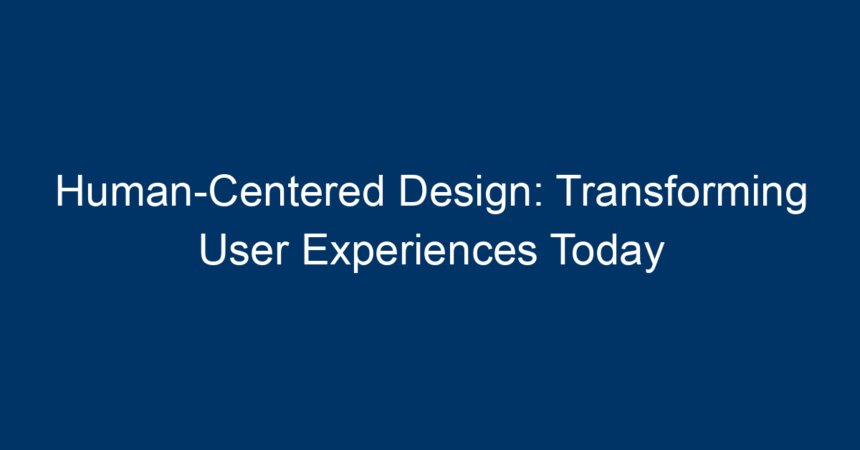In an increasingly digital world, where user interaction with technology is omnipresent, the importance of human-centered design cannot be overstated. The concept revolves around creating products and services tailored to the needs, preferences, and limitations of end-users. Today’s competitive landscape demands that businesses elevate user experiences, and human-centered design offers an innovative pathway to achieve this transformation.
What is Human-Centered Design?
Human-centered design (HCD) is an approach that places the user at the core of the design process. It emphasizes empathy and understanding of the users’ needs, providing a structured framework that enables designers and developers to create solutions that genuinely resonate.
Key Principles of Human-Centered Design
-
Empathy: Understanding users’ emotions, needs, and challenges through direct interaction and observation.
-
Involvement: Engaging users throughout the design process, from ideation to testing.
-
Iteration: Emphasizing continual learning and improvement, allowing for flexible design changes based on user feedback.
- Holistic Perspective: Considering the entire context in which a product is used, including environmental and social factors.
These principles help create user experiences that are not only functional but also emotionally fulfilling.
The Importance of Human-Centered Design
Enhancing User Experience
Human-centered design significantly enhances user experience. By focusing on users’ real needs, businesses can offer products that solve problems rather than just serve as technological solutions. This can lead to increased satisfaction, loyalty, and even recommendations.
Driving Innovation
An HCD approach fosters innovation by encouraging creativity and exploration. When designers step into the shoes of their users, they can uncover unique insights that spark new ideas. This user-first mindset can lead to groundbreaking solutions that disrupt traditional markets.
Reducing Cost and Time
Investing in human-centered design from the onset can help organizations save time and money. By focusing on user needs, companies can minimize costly redesigns post-launch. The iterative process involves testing prototypes, gathering feedback, and refining solutions early, reducing the risk of failure later on.
Applying Human-Centered Design: Steps to Follow
1. Identify User Needs
The journey of human-centered design begins with understanding who your users are and what they need. Create user personas, based on research, to define the characteristics, goals, and pain points of your target audience. Conduct interviews and focus groups to gain deeper insights into their expectations.
2. Ideation
Encourage brainstorming sessions that include diverse perspectives. Involve cross-functional teams to generate a wide array of ideas. Use techniques like mind mapping and sketching to visualize concepts. This collaborative approach can yield innovative ideas that cater to user needs effectively.
3. Prototyping
Developing low-fidelity prototypes allows you to see how ideas translate into tangible concepts. Rapid prototyping encourages quick iterations and testing. This stage focuses on translating user insights into visual designs that can be interacted with and tested.
4. Testing and Feedback
Testing prototypes with actual users is crucial. Pay attention to their interactions, observe their reactions, and gather feedback. These insights offer invaluable data that can inform further design iterations. The testing phase is where real-world applicability meets design theory.
5. Implementation
Once design iterations are made, the final solution must be executed. Ensure that developers and teams remain aligned throughout this process. Keep an open line of communication with users even after implementation, as ongoing feedback is key for continuous improvement.
The Role of Technology in Human-Centered Design
Today, technology plays a pivotal role in understanding user needs and enhancing the human-centered design process. Tools such as user experience research software, prototyping apps, and analytics platforms help designers gather data-driven insights. These tools enhance efficiency, allowing teams to analyze behavior patterns and preferences swiftly.
User Experience (UX) and Human-Centered Design
The relationship between UX and human-centered design is symbiotic. While HCD focuses on human needs, UX emphasizes how those needs can be met through design. By integrating both approaches, businesses can optimize usability, accessibility, and overall user satisfaction.
Challenges in Implementing Human-Centered Design
While human-centered design offers numerous benefits, there are challenges that organizations may face:
Resistance to Change
In many organizations, traditional design processes may be deeply entrenched. Introducing a human-centered approach may encounter resistance from stakeholders accustomed to conventional methodologies. Effective change management strategies are essential to overcome this hurdle.
Time Constraints
Designing with users in mind requires more time upfront for research and testing. Organizations may feel pressured to prioritize speed over thoroughness. Emphasizing the long-term benefits of HCD, including enhanced user loyalty and reduced redesign costs, can help mitigate this concern.
Balancing Business Goals and User Needs
Striking a balance between business objectives and user needs can be daunting. However, embracing a human-centered design philosophy doesn’t mean neglecting business KPIs; rather, it encourages aligning them with user satisfaction metrics for enhanced outcomes.
Real-World Examples of Human-Centered Design
1. Airbnb
Airbnb transformed the travel industry by putting users at the center of its design. By focusing on user preferences, safety, and ease of use, the platform created an interface that simplifies the booking process while catering to diverse user needs. Continuous feedback loops enabled Airbnb to evolve alongside its users.
2. Apple
Apple’s commitment to human-centered design is evident in its product range. The intuitive interface of the iPhone, along with accessibility features, reflects a deep understanding of user experience. Apple’s iterative design process ensures that feedback shapes new features and updates.
3. IDEO
Design firm IDEO is renowned for its human-centered design philosophy. Their work on the design of the first Apple computer and numerous other innovative products exemplifies how understanding user needs leads to groundbreaking solutions. IDEO’s process highlights the importance of empathy and iterative learning in creating impactful designs.
Conclusion: Embracing Human-Centered Design for Future Success
The world is evolving, and so are the expectations of users. Implementing a human-centered design approach is not merely a trend; it is a necessity for organizations striving to create exceptional user experiences. By genuinely understanding user needs, fostering innovation, and remaining adaptable, businesses can transform their offerings and capture the hearts of their users.
Actionable Insights
- Conduct Regular User Research: Make user feedback a continuous process rather than a one-time event.
- Encourage Collaboration: Involve diverse teams in the design process to gain various perspectives.
- Iterate Constantly: Don’t shy away from refining your designs based on user input; it leads to superior outcomes.
- Prioritize User Testing: Real-world testing of concepts can reveal invaluable insights that drive meaningful adjustments.
- Embrace Technology: Utilize available tools to streamline user research and prototype testing.
By fully embracing the principles of human-centered design, your organization can craft solutions that are not only innovative but also delightful to use, thereby setting the stage for lasting success.




